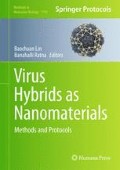Abstract
Viral nanoblock provides specific positioning of recognition moieties and dye molecules which can be used as a signal-generating element and enhance detection sensitivity. The methods described herein use a 30 nm viral nanoblock to couple a variety of proteins and peptides for the incorporation of recognition elements along with a large number of dye molecules (200). The bioconjugation techniques were adapted and optimized over the years to fabricate nanoparticles that exhibit high fluorescence output while maintaining the selectivity of the target receptors. These complexes can be used for the detection of pathogens and toxins in a single step since both receptor and reporter are in the same viral nanoblock. Its stability and nanometer size allows for its utilization in well-established sensing platforms like microarrays.
Access this chapter
Tax calculation will be finalised at checkout
Purchases are for personal use only
References
Hermanson GT (1996) Bioconjugate techniques. Academic Press, San Diego, CA, USA
Lakowicz JR (1983) Principles of fluorescence spectroscopy. Plenum Publishing Corporation, New York, NY, USA
Soto CM, Blaney KM, Dar M, Khan M, Lin BC, Malanoski AP, Tidd C, Rios MV, Lopez DM, Ratna BR (2009) Cowpea mosaic virus nanoscaffold as signal enhancement for DNA microarrays. Biosen Bioelectron 25:48–54
Soto CM, Blum AS, Vora GJ, Lebedev N, Meador CE, Won AP, Chatterji A, Johnson JE, Ratna BR (2006) Fluorescent signal amplification of carbocyanine dyes using engineered viral nanoparticles. J Am Chem Soc 128: 5184–5189
Soto CM, Ratna BR (2010) Virus hybrids as nanomaterials for biotechnology. Curr Opin Biotech 21:1–13
Seetharam RN, Blum AS, Soto CM, Whitley JL, Sapsford KE, Chatterji A, Lin T, Johnson JE, Guerra C, Satir P, Ratna BR (2008) Long term storage of virus templated fluorescent materials for sensing applications. Nanotechnology 19: 105504
Johnson JE, Lin T, Lomonossoff G (1997) Presentation of heterologous peptides on plant viruses: genetics, structure, and function. Annu Rev Phytopathol 35:67–86
Chatterji A, Ochoa WF, Paine M, Ratna BR, Johnson JE, Lin TW (2004) New addresses on an addressable virus nanoblock: uniquely reactive lys residues on cowpea mosaic virus. Chem Biol 11:855–863
Steinmetz NF, Lomonossoff GP, Evans DJ (2006) Cowpea mosaic virus for material fabrication: addressable carboxylate groups on a programmable nanoscaffold. Langmuir 22: 3488–3490
Blum AS, Soto CM, Wilson CD, Cole JD, Kim M, Gnade B, Chatterji A, Ochoa WF, Lin TW, Johnson JE, Ratna BR (2004) Cowpea mosaic virus as a scaffold for 3-D patterning of gold nanoparticles. Nano Lett 4:867–870
Wang Q, Lin T, Tang L, Johnson JE, Finn MG (2002) Icosahedral virus particles as addressable nanoscale building blocks. Angew Chem Int Ed 41:459–462
Lin T, Chen Z, Usha R, Stauffacher CV, Dai J-B, Schmidt T, Johnson JE (1999) The refined crystal structure of cowpea mosaic virus at 2.8 Å resolution. Virology 265:20–34
Sapsford KE, Soto CM, Blum AS, Chatterji A, Lin TW, Johnson JE, Ligler FS, Ratna BR (2006) A cowpea mosaic virus nanoscaffold for multiplexed antibody conjugation: application as an immunoassay tracer. Biosen Bioelectron 21:1668–1673
Martin BD, Soto CM, Blum AS, Sapsford KE, Whitley JL, Johnson JE, Chatterji A, Ratna BR (2006) An engineered virus as a bright fluorescent tag and scaffold for cargo proteins—capture and transport by gliding microtubules. J Nanosci Nanotechnol 6:2451–2460
Soto CM, Martin BD, Sapsford KE, Blum AS, Ratna BR (2008) Toward single molecule detection of staphylococcal enterotoxin B: mobile sandwich immunoassay on gliding microtabules. Anal Chem 80:5433–5440
Blum AS, Soto CM, Wilson CD, Whitley JL, Moore MH, Sapsford KE, Lin TW, Chatterji A, Johnson JE, Ratna BR (2006) Templated self-assembly of quantum dots from aqueous solution using protein scaffolds. Nanotechnology 17:5073–5079
Moore DD (1996) Appendix. Curr Protoc Mol Biol 35:A.2.1–A.2.8
Da Poian AT, Johnson JE, Silva JL (2002) Protein-RNA interactions and virus stability as probed by the dynamics of trypto-phan side chains. J Biol Chem 277: 47596–47602
Acknowledgements
The author wants to thank Prof. John E. Johnson for CPMV samples and constant collaboration, colleagues and students for their contributions to our VNB projects, and Dr. Gary Vora for his comments on the manuscript. The work was supported by the Office of Naval Research under NRL basic research core funds.
Author information
Authors and Affiliations
Editor information
Editors and Affiliations
Rights and permissions
Copyright information
© 2014 Springer Science+Business Media, New York
About this protocol
Cite this protocol
Soto, C.M. (2014). A Programmable Fluorescent Viral Nanoblock: Sensing Made Easy in a Single Step. In: Lin, B., Ratna, B. (eds) Virus Hybrids as Nanomaterials. Methods in Molecular Biology, vol 1108. Humana Press, Totowa, NJ. https://doi.org/10.1007/978-1-62703-751-8_12
Download citation
DOI: https://doi.org/10.1007/978-1-62703-751-8_12
Published:
Publisher Name: Humana Press, Totowa, NJ
Print ISBN: 978-1-62703-750-1
Online ISBN: 978-1-62703-751-8
eBook Packages: Springer Protocols

